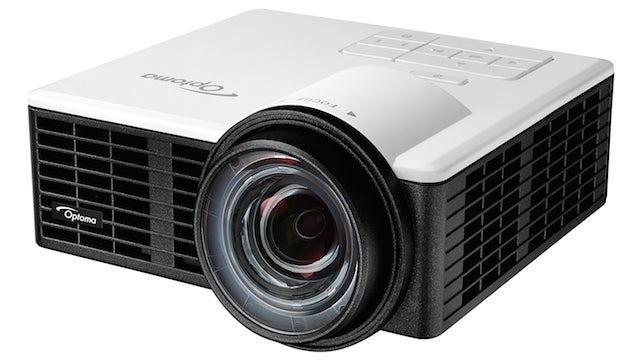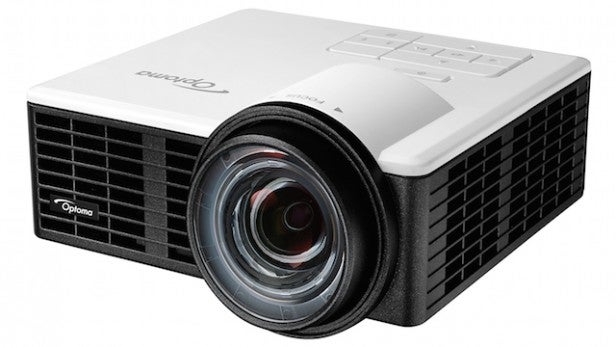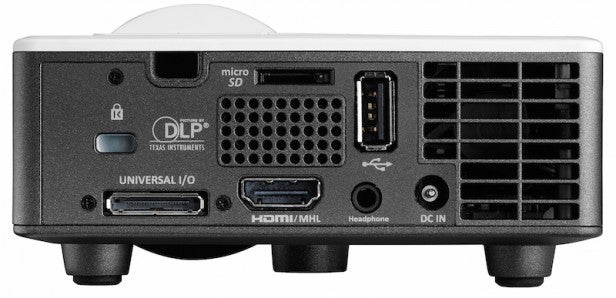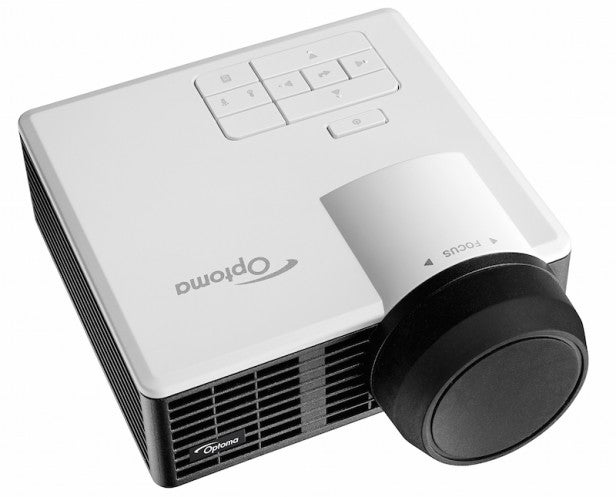Optoma ML750ST Review
Optoma ML750ST
Tiny projector, big performer

Sections
- Page 1 Optoma ML750ST Review
- Page 2 Picture Quality Review
- Page 3 Sound and Conclusions Review
Verdict
Pros
- Excellent picture quality
- Strong feature count
- Superbly portable form factor
Cons
- A touch expensive
- Fiddly remote control
- Some minor scaling issues
Key Specifications
- Review Price: £480.00
- Ultraportable DLP projector
- 20,000-hour lamp life
- WXGA native resolution
- 800 lumens of brightness
- Short-throw lens design
What is the Optoma ML750ST?
The £480 ML750ST is an ultra portable (as in, it weighs less than half a kilogram and can comfortably be held in one hand) DLP projector with a short-throw lens that Optoma believes is suited to both business and home entertainment uses.
Optoma ML750ST – Design and Features
There was a time a year or two back when ultraportable “pico” projectors that took up scarcely any room in a briefcase, or even slotted into a decent-sized jacket pocket, were ten a penny. Although the fad has died down considerably now, Optoma’s ML750ST may just have what it takes to resurrect it.
Related: Best Projectors 2016
The ML750ST is a cutie. Small enough at 112.5 x 123 x 57mm and light enough at 420g to slot almost unnoticed into a briefcase or shoulder bag, it immediately ticks all the boxes for those looking for a projector that can be used in multiple locations. It even ships with an attached rubberised lens cover and little canvas carry bag to enhance its portability.
I immediately took to its combination of a white top plate and black grilled sides, and lapped up the way its oversized lens explodes out of the front edge, creating a slight bulge in the top edge.
Proof that the ML750ST’s portability doesn’t stop at its size comes from the striking array of connections on its rear. As you’d expect these days there’s an HDMI, which is joined by an SD card slot, a USB port, a headphone jack, and a universal in/out socket (for which a cable is helpfully provided for free).
The HDMI supports the MHL protocol for sharing content from compatible mobile devices, while spending an extra £27 on Optoma’s optional wireless USB adapter (and downloading the free HDCast Pro app) will see the projector support even wireless streaming from mobile devices.
The HDMI port can be used for connecting Blu-ray players and games consoles for home entertainment uses, as well as PCs and laptops. Meanwhile, the SD card slot and USB port can be used for playing Microsoft Office, PDF, photo, video and audio files directly into the projector. This – along with some built-in memory – frees you from the need to attach a PC when putting on a business presentation. However, PowerPoint geeks should note that the ML750ST’s built-in file parsing doesn’t support PowerPoint animations.
I mentioned at the start of this review that the ML750ST uses DLP technology. But I should clarify this by adding that it uses a DLP system of individual red, green and blue LED modules, rather than the colour-wheel system sported by most full-sized DLP projectors. Such an approach is handy for two reasons.
First, it means that the projector’s lamp life is rated at a huge 20,000 hours instead of the usual 2,000-6,000 hours. Second, using individual LED modules means that when you turn off the projector you can instantly unplug it and pack it away. There’s no need to wait for the lamp to cool before unplugging the device, as is common with normal types of DLP projector.
The ML750ST claims some striking picture specifications. Its brightness of 800 lumens and claimed contrast ratio of 20,000:1 both look hugely promising by “pocket” projector standards, and while its 1,280 x 800 WXGA resolution doesn’t hit the Full HD 1,920 x 1,080 heights you’d be looking for from a £500-£600 full-sized DLP projector these days, it’s actually pretty high by pocket projector standards.
The 1,280 x 800 resolution delivers a native image aspect ratio of 16:10 rather than the 16:9 ratio of TVs and most video content. While this means 16:9 content can’t make use of every pixel available in the ML750ST, the projector does preserve the correct aspect ratio when showing 16:9 content.
It’s worth adding here that although the ML750ST clearly has one eye on the business presentations market, its separate RGB LED approach is actually pretty effective at delivering colours accurate to the Rec 709 video standard (the new HDR picture technology hasn’t yet trickled down to the budget projection world). There are also video-friendly presets, and that 20,000:1 contrast ratio claim is particularly promising for video playback.
Optoma ML750ST – Setup
The ST bit of the ML750ST’s name stands for “short throw”, and instantly reveals one of its most useful set-up features: its ability to deliver big images from a reduced throw distance. You can achieve a 100-inch image, for instance, even if the projector is only around 1m away from your screen.
More aids to set up – which needs to be easy when you’re talking about a projector as focused on portability as the ML750ST – include a reasonably effective automated keystone correction system and a built-in sensor that auto calibrates the LEDs each time the projector is switched on.
Not surprisingly, given the ML750ST’s nature and focus on convenience, it sports precious few image adjustments in its basic on-screen menus. The provided video and PC picture presets do a pretty good job with their respective source types, however.

